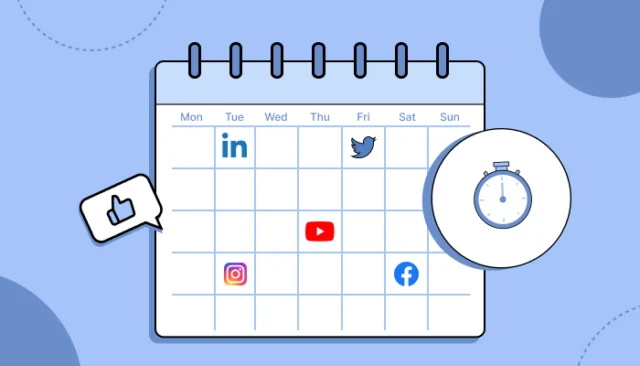In the fast-paced world of digital marketing, maintaining a consistent and strategic approach to content creation is vital for success. A well-structured content calendar can help you organize your content, streamline your workflow, and ensure that you’re meeting your marketing goals. In this blog, we’ll walk you through the steps to create an effective content calendar tailored to your needs.

Table of Contents
ToggleWhat is a Content Calendar?
A content calendar is a tool used to plan, organize, and schedule content for your marketing efforts. It outlines what content will be created, when it will be published, and where it will be shared. A content calendar can encompass various formats, including blog posts, social media updates, email newsletters, videos, and more. By using a content calendar, you can visualize your content strategy, ensure consistent posting, and align your efforts with your overall marketing goals.
Benefits of a Content Calendar
- Improved Organization: A content calendar helps you keep track of your content ideas, deadlines, and publishing schedules, reducing the chaos of last-minute content creation.
- Enhanced Collaboration: If you’re working with a team, a content calendar allows everyone to stay on the same page, facilitating collaboration and communication.
- Consistency: Regularly scheduled content fosters audience engagement and builds trust, helping you maintain a consistent brand presence.
- Strategic Planning: A content calendar allows you to plan your content around key events, holidays, or marketing campaigns, ensuring timely and relevant messaging.
Steps to Create a Content Calendar
Step 1: Define Your Goals
Before you dive into creating your content calendar, it’s essential to outline your content marketing goals. Consider the following:
- What do you want to achieve? (e.g., increase website traffic, boost social media engagement, generate leads)
- Who is your target audience? (e.g., demographics, interests, pain points)
- What type of content resonates with your audience? (e.g., blog posts, videos, infographics)
Having clear goals will guide your content planning and help you measure success.
Step 2: Choose Your Calendar Format
Content calendars can take various forms, depending on your preference and workflow. Here are a few options to consider:
- Spreadsheets: Tools like Google Sheets or Excel allow for flexibility and customization.
- Project Management Tools: Platforms like Trello, Asana, or Monday.com provide visual boards to manage tasks and deadlines.
- Dedicated Calendar Tools: Tools like CoSchedule or ContentCal are specifically designed for content planning and scheduling.
Select a format that best suits your team’s needs and workflows.
Step 3: Brainstorm Content Ideas
With your goals defined and a format chosen, it’s time to brainstorm content ideas. Gather input from team members, analyze competitor content, and consider your audience’s interests. Here are some strategies to generate ideas:
- Conduct Keyword Research: Identify relevant keywords and topics that align with your audience’s search queries.
- Leverage Social Media: Monitor trends, popular hashtags, and discussions within your industry.
- Utilize Content Gaps: Identify gaps in existing content on your site and create topics that fill those gaps.
Aim for a mix of content types and themes to keep your audience engaged.
Step 4: Organize Your Content
Once you have a list of content ideas, start organizing them into your calendar. Here’s what to include for each content entry:
- Content Title/Topic: A clear title or description of the content piece.
- Content Type: Specify whether it’s a blog post, social media update, video, etc.
- Publication Date: Set a deadline for when the content will be published.
- Responsible Person: Assign team members to oversee the creation and publishing of the content.
- Status: Track the progress of each content piece (e.g., idea, drafting, editing, scheduled, published).
- Promotion Plan: Outline how you will promote the content once it’s published (e.g., email campaigns, social media shares).
Step 5: Create a Publishing Schedule
To maintain consistency, develop a publishing schedule that outlines how often you plan to publish content. Consider the following:
- Frequency: Determine how many pieces of content you’ll publish weekly or monthly. This may vary based on your resources and audience preferences.
- Timing: Analyze when your audience is most active and adjust your posting times accordingly.
Step 6: Monitor and Adjust
A content calendar is a living document that requires regular updates and adjustments. Here’s how to keep it effective:
- Review Performance: Regularly analyze the performance of your content to identify what resonates with your audience. Use analytics tools to track engagement, traffic, and conversions.
- Adjust as Needed: Be flexible and willing to adapt your calendar based on performance metrics and changing audience needs. If a particular type of content performs well, consider increasing its frequency.
Step 7: Collaborate and Communicate
If you’re working with a team, ensure everyone is aligned and aware of their responsibilities. Regular check-ins can help:
- Discuss Progress: Hold meetings to review the status of ongoing content projects and brainstorm new ideas.
- Share Feedback: Encourage team members to provide input and feedback on content pieces, fostering collaboration and improving quality.
Conclusion
Creating a content calendar is an essential step for any business looking to enhance its content marketing strategy. By defining your goals, organizing your ideas, and establishing a consistent publishing schedule, you can streamline your content creation process and maximize engagement with your audience. Remember, a content calendar is not just a tool; it’s a strategic framework that helps you stay focused, organized, and effective in achieving your marketing objectives. Start building your content calendar today and watch your content strategy thrive!


No responses yet